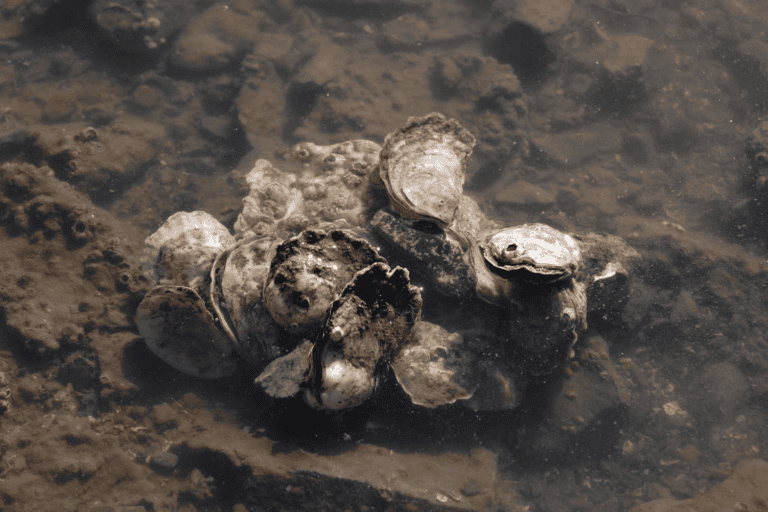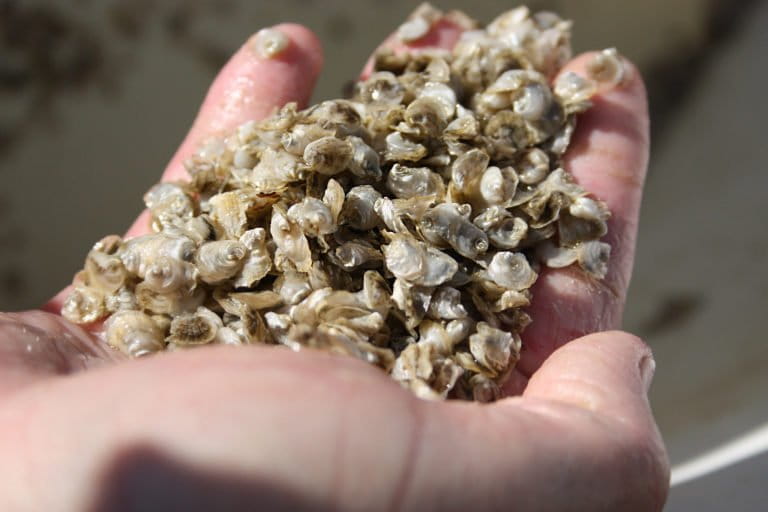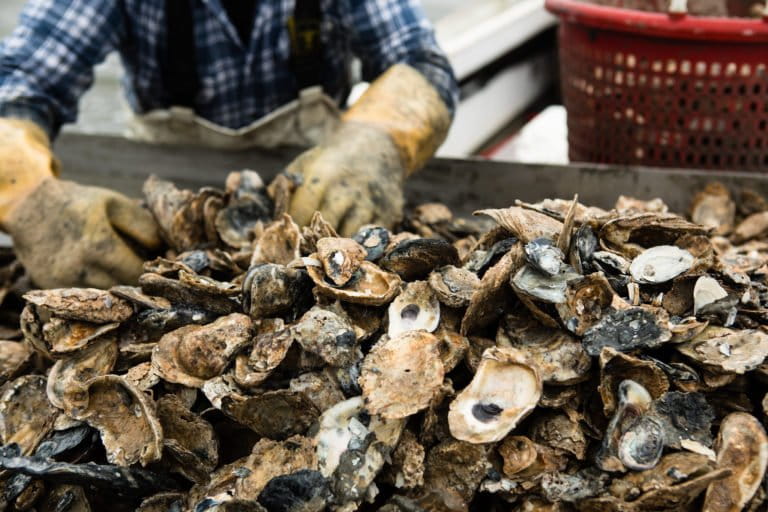- About 85% of oyster reefs across the world have been lost since the 19th century due to overharvesting, pollution, introduction of invasive species and habitat loss.
- According to a new study, Indigenous communities in North America and Australia sustainably managed oyster fisheries for more than 5,000 years before Europeans and commercial fisheries arrived.
- The knowledge of these traditional practices can guide sustainable fisheries management today, say the authors of the study.
- Mongabay interviewed Dr. Marco Hatch, one of the authors of the study, about traditional oyster and clam farming practices, existing threats to oysters, and Indigenous-led restoration efforts.
In the 18th century, when European ships sailed into the Strait of Juan de Fuca on the Northwest coast of the Pacific Ocean, they raved about the “wilderness” of the coast. The enormous natural wealth they saw—the wood from forests and the fur on animals—lured them into setting up a flourishing trade that would last centuries and script a new chapter in history.
The visitors thought the coast as pristine and untouched by humans. However, it was home to many Indigenous peoples, including the Nuu-chah-nulth, Makah, Salish, Kwakwaka’wakw and Haida peoples. These communities along the salty coasts lived here for thousands of years and stewarded the lands and ocean based on a relationship with nature rooted in reciprocity and traditional knowledge. Within a few decades, the intense trade that flourished on these lands uprooted this intricate human-nature relationship, and gave way to the commercialization of natural resources, including fisheries.

In the last 300 years, commercial fisheries have decimated many marine species across the world, including oysters. The Earth has lost about 85% of its oyster reefs since the 19th century due to overfishing, marine pollution, competition with other non-native species and habitat loss.
A landmark 2004 study, published in the Proceedings of the National Academy of Sciences, traced the expansion and collapse of 28 oyster fisheries along the coasts of North America and Australia since European commercial oyster fisheries started. It found an interesting pattern for the first time: In all these regions, the collapse began in the estuaries nearest to an urban center and expanded along the coast as each successive estuary became overfished.
Oysters from more distant estuaries were fished and transported to restock exploited estuaries near the urban center. But, prior to this commercialization, the scene of oyster fisheries under Indigenous management was very different.
Now, a new study, published in Nature Communications, studied the same sites and found that Indigenous communities in North America and Australia sustainably managed oyster fisheries for more than 5,000 years.

The researchers put together historical sea level data and derived oyster catch records using evidence from archaeological records of oyster middens (heaps of oyster shells). They found oyster fisheries thrived better in these regions than under the European settlers’ management of commercial oyster fisheries. With millions, and sometimes billions of shells harvested, some middens were as tall as 30 feet (about 9 meters), and served as important ceremonial, sacred and symbolic spaces.
Despite the bounty, large-scale depletion or declines of oysters were rare and localized due to traditional knowledge of harvest practices, consumption patterns and farming technologies.
The knowledge of these traditional practices can guide sustainable fisheries management today, say the authors.
“Conservation today can’t just be seen as a biological question and can’t just be about undoing the environmental damage we’ve done in the modern era,” explained lead author Dr. Torben C. Rick from the National Museum of Natural History, Smithsonian Institution, USA, in a press release.
“Instead, global conservation efforts should be coupled with undoing the legacies of colonialism which brought about the attempted erasure and displacement of Indigenous people all over the world,” he continued.

Dr. Marco Hatch, a marine ecologist and a member of the Samish Indian Nation, is an author of the study and has explored the Indigenous aquaculture practices in the Pacific Northwest coast, from Puget Sound through the Central Coast of British Columbia and Southeast Alaska. His Coastal Communities and Ecology Lab at the Washington Western University probes some of the ‘ecological tools’ that Indigenous communities have used for thousands of years to improve their harvest and increase the biomass of oysters and clams.
His work has also helped revive the populations of Olympia oysters (Ostrea lurida), the only native oyster on the US west coast. They are a cultural delicacy and ceremonially important oyster for the Indigenous peoples living along the Pacific Northwest coast. By the 1900s, due to over-harvesting and habitat degradation, these oysters almost went extinct. Hatch’s research helped understand where Olympia oyster larvae travel as they grow and if they could settle in different restored locations to improve their genetic diversity.
With funding from the National Science Foundation, he has also developed the Coastal Almanac, a citizen science project that involves local communities in the collection, mapping, and interpretation of data from their area to create a web-based system to collect and view environmental information of the coast.
Mongabay spoke with Dr. Hatch to find out more about his work and what traditional practices of oyster farming can teach us about sustainability in fisheries management.

INTERVIEW WITH DR. MARCO HATCH
Mongabay: How did you begin studying Indigenous fisheries practices in coastal communities?
Dr. Marco Hatch: When I graduated with my doctorate, I got a job working for a tribal college called Northwest Indian College on the Lummi Reservation. I had to shift my research interest from looking at how [coastal] environments have changed by looking at growth rate and chemistry within clamshells to developing a research program that will help engage Native American students. Around that time, I had heard of this ongoing clam garden research and in 2013, I started with some work in Bella-Bella in the Central Coast of British Columbia with the help of Heiltsuk First Nation to understand where these clam gardens are, how many they are and recording the biomass and growth rate of clams within these [gardens] to highlight how Indigenous practices have positive environmental impacts. Since then, I’ve done a variety of projects up and down the coast.
Mongabay: What unique roles do clams and oysters play in the culture and diet of Indigenous communities you have worked with?
Dr. Marco Hatch: To me, oysters are a celebration and they’ve always been that way because of its values—it’s fresh from the sea. It’s a special treat. Oysters are not in our everyday food as you can only get them only during certain times of the year, and most don’t survive that long out of the water so they aren’t preserved and stored. It’s always been a special thing to have an oyster. The Indigenous communities harvest them for ceremonial and subsistence use.
You could argue that the reason we’ve lost all of these Olympia oysters was because of that ‘specialness’ of them—they were so desired that they were over harvested. That decimated native populations, which were then supplanted by non native aquaculture species that did better in aquaculture.

Mongabay: Could you give us a glimpse of what Indigenous aquaculture looked like about 5,000-10,000 years ago in the Pacific Northwest coast?
Dr. Marco Hatch: The Olympia oyster would form large beds or reefs in shallow muddy bays in areas at the interface of freshwater and marine water. Often, shellfish beds were tended or stewarded by a certain family. So, when you’re out in the water, you wouldn’t just stop on any beach and pick oysters or dig clams—that section of beach belonged to a certain family. If you had a connection to that family, you could go access those resources. If you didn’t, you would either have to ask permission. There was somebody in charge of all of these different spots; it wasn’t just free for all.
Because of that practice, it allowed somebody to have that understanding of that spot, and be able to watch it through time. [They could decide] there’s a fair amount of oysters out there and probably harvest some and open up more space for others, or wait a bit before harvesting if it’s not looking good. It was a reciprocal relationship both between families and the beaches, and with those families and one another about who went where. There was a system of governance control.
Mongabay: How did we, in your opinion, lose this management of resources and end up depleting most of the oysters around the world?
Dr. Marco Hatch: One is the classic tragedy of the commons. In the early days of [commercial] oyster harvesting in the state of Washington, you could just go and dredge the entire reef, bring it all on land, pick out the ones you wanted and leave all the rest on land and they would die. They had to [later] pass a law to tell people that the little oysters that are too small to eat, have to be put back in the water. Because you weren’t connected to that piece of land, you could just pull everything up, let all the babies die on the beach, take a few adults and then that area is now dead. But it doesn’t matter because you’re just gonna move on to the next spot, right? It’s this classic expansion of harvesting something that you have no ties to—it’s the classic tragedy of the commons.
Then, the state of Washington is very unique in that a large amount of our intertidal is privately owned, which ties back into the aquaculture industry. That’s actually prevented a lot of access to different areas [preventing people from tending to the beach as they once used to].

Mongabay: What threats do oysters face around the world today?
Dr. Marco Hatch: If you want to have a healthy oyster, it really starts with the watershed. Everything on the land runs off into the sea. A lot of oysters live in the estuarine areas where the freshwater and the marine waters interact. In those locations you’re actually hit by a double whammy—you’ve got ocean conditions (increase in tides, temperature and acidification, etc.) coming in from one side and then river conditions (land development, waste management, stormwater treatment, etc.) coming in from the other. Oysters are at this narrow thin interface with those two, so they’re faced by threats from both sides.
One of the big threats impacting oysters is coastal development, either directly due to runoff, bacteria activities with fecal coliform, other toxins and pollutants, or [indirectly] through sedimentation. Oysters, unlike clams, can’t move up and down, and so they’re really sensitive to the sediments coming down from the watershed and covering them up. In Puget Sound, we have some shoreline armoring issues, where, instead of having a smooth, gradual beach, there’ll be a big rock or a big concrete wall in the intertidal and that causes waves to bounce off of that wall, and scour the sediment in front of it.
Mongabay: Given that there are proven practices to sustainably farm oysters, how are Olympia oysters being restored? Are any of these efforts led by Indigenous communities?
Dr. Marco Hatch: There’s a number of places that we can look at based on archaeological data to say [a given] spot has been a hot spot for oysters for thousands of years. As we move to bring the species back, it would make sense to start in those areas. In places like Fidalgo Bay, a restoration project started about 20 years ago has been widely successful. There’s a ton of oysters in that spot. So it is a species we can bring back, and hopefully it will be open for harvesting again.
There’s also a lot of partnership [with Indigenous communities] through the Puget Sound Restoration Fund. There are a few tribally owned shellfish hatcheries (like this one in Lummi), where they have done Olympia oyster spawning in the past. There are other groups that are concerned about not just oysters, but many of the native clams that don’t have commercial value. Because of that, they feel the need to be leaders in how we propagate those shellfish and how we see beaches. [Indigenous communities] are taking leadership and trying to figure out how to spawn those and how to seek the beaches.

We can look at reactivating Indigenous fishery management, like tending beaches, clam gardens and reef net fishing, as examples of tools and technologies that have been used for thousands of years to create sustainable fisheries.
Mongabay: What do you think are some of the challenges in adapting traditional knowledge in today’s fisheries management?
Dr. Marco Hatch: Promoting some of the marine management is often hard because in a state-federal management scheme, things still need to fit within that epistemology and within that way of knowing. We’ve had to generate knowledge as both conversant in traditional ecological knowledge and in mainstream or western science. That’s not always possible, and it doesn’t always make sense. When an elder tells you— “we do this, and that’s just what we’ve always done”, how do you put that in a context for which a mainstream trained resource manager would understand? Maybe that’s not possible. So, we’re kind of stuck in a lot of these conundrums where we need to think about how to incorporate multiple ways of knowing into these practices and management. In some places I think we’ve got some examples of leading the way and others would probably still have some work to do.
Mongabay: As an Indigenous researcher, what does learning about traditional practices and working with Indigenous communities mean to you?
Dr. Marco Hatch: I am a member of the Samish Indian nation which is a Coast Salish tribe in northern Puget Sound. Our traditional homelands are the San Juan Islands and the adjacent mainland—right on the US-Canadian border.
What’s really powerful [about studying Indigenous practices] is that these coastal ecologies, [which have been] sleeping or dormant, are being reawakened. We’re seeing communities up and down the coast reclaim this practice of beach management tending. It signifies the importance of Indigenous resource management—how this combination of humans, harvest and environment doesn’t equal a negative. A community I’m working with now [is] creating the first clam garden in the modern era. Clam gardens are vibrant ecosystems because people have modified them, tended them and harvested them. All of that has created positive feedback where the environment is in fact more abundant—there’s more clams and they grow faster.
So, I think that’s a fundamentally different way of viewing human interaction with nature. We’re in a very unique environment where for the past well over 10,000 years, people who have been on this land and on these shores, engaged in a reciprocal relationship with the land and sea and we’ve lost [them] over the past few hundred years.

Banner image: Dr. Marco Hatch at one of his study sites. Image courtesy of Dr. Marco Hatch.
Related listening from Mongabay’s podcast: We look at Indigenous peoples’ long relationship with, and stewardship of, marine environments through two stories of aquaculture practice in New Zealand and Canada. Listen here:
FEEDBACK: Use this form to send a message to the author of this post. If you want to post a public comment, you can do that at the bottom of the page.
